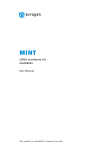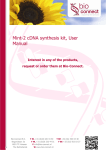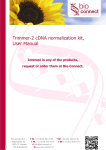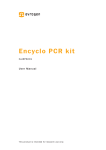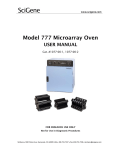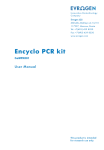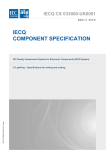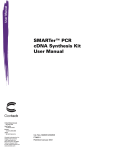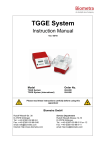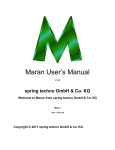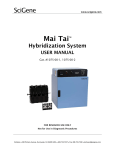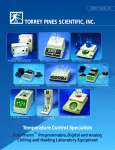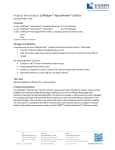Download MINT Universal cDNA synthesis kit
Transcript
MINT-Universal cDNA synthesis kit Cat#SK002 User Manual This product is intended for research use only. TABLE OF CONTENTS I. Intended use 1 II. Method overview 1 III. Kit components and storage conditions 4 IV. General considerations 6 V. 7 RNA requirements VI. cDNA preparation protocolI (cDNA for nondirectional 9 cloning) VII. cDNA preparation protocolII (cDNA for directional 19 cloning) VIII. Troubleshooting guide 29 IX. Appendixes Appendix A. Recommendations to perform 32 nondenaturing agarose gel electrophoresis of RNA Appendix B. ds cDNA Polishing Appendix C. Virtual Northern blot X. References XI. Related products 33 33 34 35 A. Encyclo PCR kit B. Trimmer cDNA normalization kit C. Trimmerdirect cDNA normalization kit Endnotes MINTUniversal User Manual 36 www.evrogen.com 1 I. Intended use MINTUniversal cDNA synthesis kit is designed to synthesize full lengthenriched double stranded (ds) cDNA from total or polyA + RNA. Synthesized cDNA can be used in various applications including preparation of directionally or nondirectionally cloned cDNA libraries, Virtual Northern blot (Franz et al., 1999), subtractive hybridization (SSH, Diatchenko et al., 1996; Diatchenko et al., 1999), and cDNA normalization using duplexspecific nuclease (Zhulidov et al., 2004; Zhulidov et al., 2005). II. Method overview MINT cDNA synthesis is based on a novel technology utilizing the specific features of MMLVbased reverse transcriptase (RT). The workflow to prepare cDNA using the MINTUniversal cDNA synthesis kit is shown in Fig. 1. First strand cDNA synthesis starts from the 3’end adapter compris ing oligo(dT) sequence to anneal to polyA + stretch of RNA. When RT reaches the 5' end of the mRNA, it adds several nontemplate nucleotides, primarily deoxycytidines, to the 3' end of the newly syn thesized firststrand cDNA (Schmidt & Mueller, 1999). This oligo(dC) stretch base pairs to complementary oligo(dG) sequence located at the 3' end of a special 30mer deoxyribooligonucleotide called PlugOligo. RT identifies PlugOligo as an extra part of the RNAtem plate and continues first strand cDNA synthesis to the end of the oligonucleotide, thus incorporating PlugOligo sequence into the 5' end of cDNA. The last 3'dG residue of the PlugOligo is a terminator nucleotide comprising 3'phosphate group. This blocking group prevents unwanted annealing and extension of the PlugOligo. Under standard conditions RT can hardly use PlugOligo as a template, however our special IPsolution (solution for Incorporation of PlugOligo sequence) dramatically increases the efficiency of this process. Technical support: [email protected] 2 II. Method overview ...continued At the final step, ds cDNA is amplified by PCR. Use of Encyclo poly merase and specially designed primers allows synthesis of full lengthenriched cDNA that is flanked by PlugOligo and 3’end adapter sequences. MINTUniversal cDNA synthesis kit comprises two pairs of adapters allowing synthesis of cDNA with different flanking sequences. RNA 3’end adapter First strand cDNA synthesis Mint RT PlugOligo PlugOligo Incorporation IPsolution ds cDNA preparation by PCR PCR primer M1 Amplified cDNA cDNA cloning Figure 1. Schematic outline of Mint cDNA synthesis workflow. MINTUniversal User Manual www.evrogen.com II. Method overview ...continued 3 The first pair is 3’end adapter CDS1 and 5’end adapter PlugOligo 1 (both are identical to that included into the Mint cDNA synthesis kit, Cat. #SK001). These adapters comprise extensive common sequence and allow synthesis of cDNA ready to nondirectional cloning (see cDNA synthesis protocolI at the Section VI). The cDNA is also well suited for other common applications like Virtual Northern blot (Franz et al., 1999), subtractive hybridization (SSH, Diatchenko et al., 1996; Diatchenko et al., 1999), etc. This cDNA can be normalized using Evrogen Trimmer kit (Evrogen Cat. #NK001). The second adapter pair is 3’end adapter CDS3M and 5’end adapter PlugOligo3M. The adapters comprise asymmetric sites for SfiI restriction enzyme (SfiA & SfiB; Fig. 2). Being incorporated at the 5' and 3' ends of the cDNA the sites allow directional cloning of the cDNA library. After digestion with SfiI and size fractionation, synthe sized cDNA can be ligated into an appropriate SfiIdigested vector. Prior to cloning, cDNA can be normalized using Evrogen Trimmer direct kit (Evrogen Cat. #NK002). See protocolII for synthesis of cDNA for directional cloning at the Section VII. Important note: In the case of cDNA prepared for directional cloning, a sizeseparation procedure is recommended before cloning to remove lowmolecularweight cDNA fragments that are often gener ated during cDNA amplification. SfiIA site SfiIB site 5’-GGCCATTACGGCC-3’ 5’-GGCCGCCTCGGCC-3’ 3’-CCGGTAATGCCGG-5’ 3’-CCGGCGGAGCCGG-5’ Figure 2. SfiI (A & B) recognition sites. Technical support: [email protected] 4 III. Kit components and storage conditions A. List of kit components MINTUniversal cDNA synthesis kit provides components for 20 reactions of ds cDNA synthesis. The kit comprises two adapter pairs wherein the first pair (CDS1 and PlugOligo1) allows synthesis of cDNA suitable for nondirectional cloning (see protocolI, Section VI), while the second (CDS3M and PlugOligo3M) is for synthesis of cDNA for directional cloning (see protocolII, Section VII). Package of the kit includes a free sample of Mint reverse transcrip tase for firststrand cDNA synthesis and a free trialsize Encyclo PCR kit (Cat #PK001). For important information about the use of MINT Universal kit, please see the ENDNOTES at the end of this User Manual. BOX 1 Component Amount 5X FirstStrand Buffer 80 μl DTT (20mM) 30 μl 10X dNTP mix (10mM each) 25 μl PlugOligo1 adapter (15 μM)* 5'AAGCAGTGGTATCAACGCAGAGTACGGGGGP3' 25 μl CDS1 adapter (10 μM)* 5'AAGCAGTGGTATCAACGCAGAGTAC(T)30VN 3' 25 μl PlugOligo3M adapter (15 μM)* 25 μl 5'AAGCAGTGGTATCAACGCAGAGTGGCCATTACGGCCGGGGGP3' CDS3M adapter (10 μM)* 25 μl 5'AAGCAGTGGTATCAACGCAGAGTGGCCGAGGCGGCC(T)20VN 3' Mint Reverse Transcriptase 20 μl IPsolution 130 μl Control total RNA template (0.5 μg/μl) 15 μl Sterile RNase free water 1.8 ml MINTUniversal User Manual www.evrogen.com III. Kit components and storage conditions ...continued 5 BOX 2 Component Amount 50X Encyclo polymerase mix 50 μl 10X Encyclo buffer 300 μl PCR Primer M1 (10 μM) 5'AAGCAGTGGTATCAACGCAGAGT3' 100 μl 50X dNTP mix (10mM each) 80 μl Sterile RNase free water 1.8 ml Control amplified cDNA sample 1 (for electrophoresis) 25 μl Control amplified cDNA sample 2 (for electrophoresis) 25 μl *RsaI and SfiI restriction sites are underlined; N = A, C, G or T; V = A, G or C Shipping & Storage: Encyclo Polymerase mix, Mint Reverse Transcriptase, PlugOligo adapters and control RNA are shipped at 20 OC (or below). All other components of the kit can be shipped at ambient temperature. Once arrived, the kit must be kept at 20 OC. B. Materials required but not included: - Biology grade mineral oil RNase Inhibitor (20 u/μl, Ambion) /optional/ - Blue ice - Sterile 0.5 or 0.2 ml PCR tubes, and sterile microcentrifuge 1.5 ml tubes - Pipettes (P10, P20, P200) and pipette tips (pipette tips with hydrophobic filters are recommended for all procedures) - Vortex - Microcentrifuge - Agarose gel electrophoresis reagents and equipment - DNA size markers (1kb DNA ladder) - PCR thermal cycler Columns for size selection of cDNA, equilibrated in TE buffer (e.g. Clontech СHROMA SPIN TM400 or 1000) /for size separation of cDNA for directional cloning/ Technical support: [email protected] 6 IV. General considerations PLEASE READ THE ENTIRE PROTOCOL BEFORE STARTING 1. Wear gloves to protect RNA and cDNA samples from degradation by nucleases. 2. If possible, perform cDNA synthesis, PCR reaction preparation and postPCR analysis in separate laboratory areas to avoid cross contamination of samples. 3. Use PCR pipette tips containing hydrophobic filters to minimize contamination. 4. We recommend that you perform a positive control cDNA synthe sis from the total RNA provided in the kit in parallel with your exper iment. This control is performed to verify that all components are working properly. 5. After solution is just thawed we strongly recommend that you mix it by gently flicking the tube and spin the tube briefly in a microcen trifuge to deposit contents at the bottom before use. 6. Add enzyme to reaction mixture last and thoroughly mix it by gen tly pipetting the reaction mixture up and down. 7. Do not increase the amount of enzymes added or concentration of RNA and cDNA in the reactions. The amounts and concentrations have been carefully optimized. MINTUniversal User Manual www.evrogen.com 7 V. RNA requirements PLEASE READ THE ENTIRE PROTOCOL BEFORE STARTING Note: The sequence complexity and the average length of the MINT cDNA noticeably depend on the quality of starting RNA material. 1. The protocol has been optimized for both total and polyA + RNA. The minimum amount of starting material for cDNA synthesis is 250 ng of total RNA or 100 ng of polyA + RNA. However, for better results we recommend that you use at least 11.5 μg of total RNA or 0.5 μg of polyA + RNA to start first strand cDNA synthesis. Note: Representation of the resulting amplified cDNA depends on the initial amount of RNA used for the firststrand cDNA synthesis. Thus, if possible, use the higher starting amounts of RNA indicated in the following protocol. 2. There are a number of methods suitable for RNA isolation providing stable RNA preparation from a majority of biological objects, for exam ple Trizol method (GIBCO/Life Technologies), Chomczynski & Sacchi method (Chomczynski & Sacchi, 1987), and RNeasy kits (QIAGEN). 3. After RNA isolation, we recommend RNA quality estimation using gel electrophoresis before the firststrand cDNA synthesis. Denaturing formaldehyde/agarose gel electrophoresis should be performed as described (Sambrook et al., 1989). Alternatively, stan dard agarose/ethidium bromide (EtBr) gel electrophoresis can be used to quickly estimate RNA quality (see Appendix A for recommendations to perform a nondenaturing agarose gel electrophoresis of RNA). The following characteristics indicate successful RNA preparation: For mammalian total RNA, two intensive bands at approximately 4.5 and 1.9 kb should be observed against a light smear. These bands represent 28S and 18S rRNA. The ratio of intensities of these bands should be about 1.52.5:1. Intact mammalian polyA + RNA appears as a smear sized from 0.1 to 47 (or more) kb with faint 28S and 18S rRNA bands. Technical support: [email protected] 8 V. RNA requirements ...continued In the case of RNA from other sources (plants, insects, yeast, amphibians), the normal mRNA smear on the nondenaturing agarose gel may not exceed 23 kb. Moreover, the overwhelming majority of invertebrates have 28s rRNA with a socalled "hidden break" (Ishikawa, 1977). In some organisms the interaction between the parts of 28s rRNA is rather weak, so the total RNA preparation exhibits a single 18slike rRNA band even on a nondenaturing gel. In other species the 28s rRNA is more robust, so it is still visible as a second band. Note: If your experimental RNA is shorter than expected and/or degraded according to electrophoresis data, prepare fresh RNA after checking the quality of RNA purification reagents. If problems per sist, you may need to find another source of tissue/cells. In some cases, partially degraded RNA is only available (e.g. tumor samples or hard treated tissues). This RNA can be used for cDNA preparation, however the cDNA sample will contain reduced number of fulllength molecules. 4. Commonly, genomic DNA contamination does not exceed the amount seen on the agarose/EtBr gel as a weak band of high molec ular weight. Such contamination does not affect cDNA synthesis. DNase treatment to degrade genomic DNA is not recommended. In some cases, excess of genomic DNA can be removed by LiCl precip itation or by phenol:chloroform extraction. MINTUniversal User Manual www.evrogen.com 9 VI. cDNA preparation protocolI PLEASE READ THE ENTIRE PROTOCOL BEFORE STARTING Important Notes: This protocol allows synthesis of cDNA ready to use for nondirectional cloning of cDNA library, Virtual Northern blot, RACE, and suppression subtractive hybridiza tion. To prepare cDNA for directional cloning please use proto colII in the Section VII below. To verify that all kit components are working properly, perform a positive control cDNA synthesis with human RNA provided in the kit in parallel with your experimental samples. Before you begin the first cDNA synthesis procedure, shake all enzymes solutions and spin the tubes briefly in a microcen trifuge. A. Firststrand cDNA synthesis and PlugOligo incorporation Note: During the first strand cDNA synthesis, the use of a thermal cycler for incubation steps is recommended. Using the air thermo stat may require additional optimization. 1. For each RNA sample, combine the following reagents in a sterile thin 0.2 ml (or 0.5 ml) tube: X μl 13 μl Sterile water RNA sample (containing 0.25 2 μg of total or 0.11.0 μg of polyA + RNA) For the control reaction use 2 μl of the control RNA 1 μl CDS1 adapter (10 μM) 1 μl PlugOligo1 adapter (15 μM) 5 μl Total volume Note: Before taking aliquots, heat the RNA samples at 65 OC for 12 min and mix the content by gently flicking the tubes to prevent RNA aggregation. Spin the tubes briefly in a microcentrifuge. Technical support: [email protected] 10 VI. cDNA preparation protocolI ...continued 2. Gently pipette the reaction mixtures and spin the tubes briefly in a microcentrifuge. 3. If you use a thermal cycler that is not equipped with a heated lid, overlay each reaction with a drop of molecular biology grade miner al oil. This will prevent the loss of volume due to evaporation. 4. Close the tubes and place them into a thermal cycler. 5. Incubate the tubes in a thermal cycler at 70 OC for 2 min (use heat ed lid). 6. Decrease the incubation temperature to 42 OC. Keep the tubes in the thermal cycler at 42 OC for a time required to prepare RT Master mix (from 1 to 3 min). 7. Simultaneously with steps 56 prepare a RT Master mix for all reaction tubes by combining the following reagents in the order shown: per rxn (the recipe must be adjusted for multiple samples) 2 μl 5X FirstStrand Buffer 1 μl DTT (20 mM) 1 μl 10X dNTP (10 mM each) 1 μl Mint reverse transcriptase 5 μl Total volume If required, 0.5 μl of RNase Inhibitor (20 u/μl, Ambion) can be added to the reaction. 8. Gently pipette the RT Master mix and spin the tube briefly in a microcentrifuge. 9. Add 5 μl of the RT Master mix into each reaction tube from Step 6. Gently pipette the reaction mix and if required spin the tubes briefly in a microcentrifuge to deposit contents at the bottom. Note: Do not remove the reaction tubes from the thermal cycler except for the time necessary to add RT Master mix. MINTUniversal User Manual www.evrogen.com VI. cDNA preparation protocolI ...continued 11 10. Incubate the tubes at 42 OC for 30 min, after that proceed imme diately to step 11. 11. Add 5 μl of the IPsolution to each reaction tube, mix by gently pipetting, if required spin the tubes briefly in a microcentrifuge and continue incubation of the tubes at 42 OC for 1h 30 min. Note: Do not remove the reaction tubes from the thermal cycler except for the time necessary to add IPsolution. 12. Place the tubes on ice to stop reaction. Note: A brown sediment may be generated in the reaction(s). It does not affect following pro cedures. First strand cDNA prepared can be used immediately for ds cDNA synthesis (Section VI.B) or stored at 20 OC up to three months. B. ds cDNA synthesis by PCR amplification Important Notes: 1. Use of the optimal number of PCR cycles ensures that the ds cDNA remains in the exponential phase of amplification. This is cru cial for many applications like Virtual Northern blot (Franz et al., 1999) or selective subtraction hybridization (Diatchenko et al., 1996; Diatchenko et al., 1999). PCR overcycling yields nonspecific PCR products and is extremely undesirable for these applications. PCR undercycling results in a lower yield of PCR product. The optimal number of PCR cycles must be determined individually for each experimental sample. The protocol provided includes the procedure of evaluative PCR in a small reaction volume to determine the opti mal number of PCR cycles (section B1) and subsequent fullsize preparation of ds cDNA (section B2). 2. In parallel with your experimental samples we recommend that you perform a positive control PCR with the first strand cDNA obtained from the control human RNA provided in the kit. This con trol is used to verify that all components are working properly. Technical support: [email protected] 12 VI. cDNA preparation protocolI ...continued 3. Cycling parameters in this protocol have been optimized for a MJ Research PTC200 DNA. Optimal parameters may vary with different thermal cyclers, polymerase, and templates. B1. Evaluative PCR 1. For each first strand cDNA sample prepare PCR Master Mix by combining the following reagents in the order shown*: 40 μl Sterile water 5 μl 10X Encyclo PCR Buffer 1 μl 50X dNTP mix (10 mM each) 2 μl PCR Primer M1 (10 μM) 1 μl 50X Encyclo Polymerase Mix 1 μl Firststrand cDNA (from Step VI.A.12)** 50 μl Total volume Notes: * The recipe is for three reactions of 16 μl and must be adjusted for multiple samples or other reaction volumes. In the case of multiple samples, first prepare a PCR Master Mix in a sterile 0.5 ml tube for all samples combining all reagents shown except the firststrand cDNA. Then aliquot 49 μl of the PCR Master Mix into the appropriate number of fresh sterile 0.5 ml tubes and add 1 μl of the firststrand cDNA solutions (from Step VI.A.12). ** If your firststrand cDNA samples were stored at 20 OC, preheat the firststrand cDNA reactions at 65OC for 1 min and mix contents by gently flicking the tube before taking aliquots. Store the remaining firststrand cDNA in blue ice if you plan to perform fullsize cDNA preparation (section B.2) directly after evaluative PCR. If you plan to perform fullsize cDNA preparation sometime later, store the remain ing firststrand cDNA at 20 OC. 2. Mix PCR components by gently flicking the tube. Spin the tube briefly in a microcentrifuge. MINTUniversal User Manual www.evrogen.com VI. cDNA preparation protocolI ...continued 13 3. Aliquot 16 μl of PCR reaction into PCR tubes (three tubes for each first strand cDNA). Label the tubes as <S>1, <S>2, and <S>3, wherein <S> is a sample identifier. Note: Thinwall PCR tubes are recommended. These PCR tubes are optimized to ensure more efficient heat transfer and to maximize thermalcycling performance. We recommend that you use 0.2 ml PCR tubes rather than 0.5 ml ones. 4. Overlay each reaction with a drop of mineral oil (1520 μl). Close the tubes, and place them into a thermal cycler. Note: Because of a small reaction volume, we recommend that you perform evaluative PCR under the mineral oil even if you use a ther mal cycler equipped with a heated lid. 5. Commence thermal cycling using the following program: Step Number of cycles Temperature Initial denaturation 1 95 OC for 1min Cycling X* 95 OC for 15 s; 66 OC for 20 s; 72 OC for 3 min Final Extension 1 66 OC for 15 s; 72 OC for 3 min *X is a number of cycles shown in Table 1 for a given amount of total or polyA+ RNA used in the firststrand synthesis. Technical support: [email protected] 14 VI. cDNA preparation protocolI ...continued Table 1. PCR cycling parameters Total RNA (μg) PolyA + RNA (μg) Number of PCR cycles for tubes: <S>1 <S>2 <S>3 1.02.0 0.51.0 1314 1617 1920 0.51.0 0.10.5 1415 1718 2021 0.10.5 0.1 or rather less 1617 2021 2324 Note: Cycling parameters in this protocol have been optimized for MJ Research PTC200 DNA thermal cycler and Encyclo polymerase mix. Optimal parameters may vary with different thermal cyclers, polymerases, and templates. If you use another thermal cycler, addi tional optimization of PCR parameters may be required. See Troubleshooting Guide for details. 6. Analyze 4 μl aliquots of each PCR product alongside 0.1 μg of 1 kb DNA size marker and 4 μg of control cDNA sample 1 on a 1.2% agarose/EtBr gel in 1X TAE buffer. Compare the PCR product you have obtained with that in Fig. 3 (relative to the 1kb DNA ladder size markers). Use guidelines in the step 7 to determine samples with an optimal number of PCR cycles. Note: PCR product can be stored at 20 OC up to three months. If amplified samples were frozen before electrophoresis, heat them at 72OC for 2 min and mix before loading onto the agarose gel. 7. Analysis of PCR result. When the yield of PCR products stops increasing with every addition al cycle, the reaction has reached its plateau. The optimal number of cycles for your experiment should be one or two cycles less than that needed to reach the plateau. Be conservative: when in doubt, it is better to use fewer cycles than too many. Figure 3 shows a characteristic gel profile of ds cDNA synthesized using the control human brain total RNA following the Mint protocol outlined in Section VI. In the experiment showed, 1 μg of control RNA MINTUniversal User Manual www.evrogen.com VI. cDNA preparation protocolI ...continued 15 was used for cDNA synthesis. PCR products (4 μl per lane) after 15, 18, 21 and 24 cycles were analyzed on a 1.2% agarose/EtBr gel in 1X TAE buffer alongside 0.1 μg of 1 kb DNA size markers. M 15 18 21 24 5.0 3.0 C Figure 3. Agarose gel (1.2%) electrophoresis of amplified control cDNA after different number of P CR cycles. The number of PCR cycles per formed is indicated at the top . M 1 kb DNA size marker, SibEnzyme, Russia; C control cDNA sample 1. 1.5 1.0 After 21 cycles, a smear appeared in the highmolecularweight region of the gel, indicating that the reaction is overcycled. Because the plateau was reached after 20 cycles, the optimal cycle number for this experiment is 1819. Typical results, indicative of a successful PCR, should have the fol lowing characteristics: 1. A moderately strong cDNA smear of expected size distribution. For cDNA prepared from most mammalian RNA, the overall signal intensity (relative to the 1kb DNA ladder size markers, 0.1 μg run on the same gel) should be roughly similar to that shown for the control experiment in Fig. 3, lane 2. If the cDNA smear appears in the high molecularweight region of the gel (e.g. as in lane 4), especially if no bright bands are distinguishable, this could indicate overcycled PCR (too many amplification cycles). If the smear is much fainter (lane 1), this could indicate PCR under cycling (too few cycles). Technical support: [email protected] 16 VI. cDNA preparation protocolI ...continued If the size distribution of cDNA is generally less than expected (for example less than 3 kb for cDNA from mammalian sources), this could indicate that initial RNA is of poor quality or degraded during storage/synthesis. Note: In general, ds cDNA size distribution should be similar to cor respondent mRNA, which typically appears within the range of 0.5 10 kb on an agarose/EtBr gel. For most mammalian tissues visible smear of fulllengthenriched cDNA should be within the range of 0.56 kb, while normal cDNA size for many nonmammalian species is less than 3 kb (Fig. 4). 2. Several bright bands corresponding to abundant transcripts. A number of distinct bright bands are usually present in cDNA pre pared from many tissue sources. Band visibility depends on gel elec trophoresis parameters, RNA source, etc. However, if bright bands diffuse during PCR cycling, this could indicate PCR overcycling. If PCR undercyycling is observed in all <S>1<S>3 samples, subject es (plus 1 final exten the samples to two or three additional PCR cycle sion extra cycle) and recheck the products. Note: Representation of the resulting amplified cDNA strongly depends on the initial number of target DNA molecules used for PCR amplification and accordingly on the number of PCR cycles required to amplify cDNA to the amount of 510 ng/μl (when it becomes visi ble on agarose/EtBr gel). Please remember that if cDNA requires more than 26 PCR cycles to be amplified it probably doesn't contain rare transcripts. If no or low yield PCR product is observed after 25 cycles, see Troubleshooting Guide. MINTUniversal User Manual www.evrogen.com VI. cDNA preparation protocolI ...continued 17 B2. Fullsize preparation of ds cDNA 1. For each first strand cDNA sample prepare a PCR Master Mix by combining the following reagents in the order shown: per rxn (the recipe must be adjusted for multiple samples or other reaction volumes): 40 μl Sterile water 5 μl 10X Encyclo PCR Buffer 1 μl 50X dNTP mix (10 mM each) 2 μl PCR Primer M1 (10 μM) 1 μl 50X Encyclo Polymerase Mix 49 μl Total volume 2. Mix PCR components by gently flicking the tube. Spin the tube briefly in a microcentrifuge. 3. Aliquot 49 μl of PCR Master Mix into the appropriate number of PCR tubes. Note: Thinwall PCR tubes are recommended. These PCR tubes are optimized to ensure more efficient heat transfer and to maximize thermalcycling performance. We recommend that you use 0.2 ml PCR tubes rather than 0.5 ml ones. 4. Add 1 μl aliquot of the first strand cDNAs (from step A.12) into the tubes. Note: If your firststrand cDNA samples were stored at 20 OC, pre heat the firststrand cDNA reactions at 65 OC for 1 min and mix by gently flicking the tubes before taking aliquots. Store the remaining firststrand cDNA at 20 OC. 5. If you use a thermal cycler that is not equipped with a heated cover, overlay each reaction with a drop of mineral oil. Close the tubes, and place them into a thermal cycler. Technical support: [email protected] 18 VI. cDNA preparation protocolI ...continued 6. Commence thermal cycling using the following program: Step Number of cycles Temperature Initial denaturation 1 95OC for 1min Cycling N* 95OC for 15 s; 66 OC for 20 s; 72 OC for 3 min Final Extension 1 66OC for 15 s; 72 OC for 3 min *N is the optimal number of cycles determined previously (section VI.B.1). 7. Analyze 4 μl aliquots of each PCR product alongside 0.1 μg of 1 kb DNA size marker and 4 μl aliquot of the Control cDNA sample 1 on a 1.2% agarose/EtBr gel in 1X TAE buffer. If required, add 12 additional PCR cycles. Now, you have obtained amplified ds cDNA. This cDNA can be stored at 20 OC up to six months. It can be used for nondirectional cloning of cDNA library into TA cloning vectors. Before cloning, purification of a PCR product is rec ommend using phenolchloroform extraction or commercial PCR purification kits. After polishing procedure (see Appendix B) the cDNA can be non directionally cloned using blunt ends into any other vector of choice. Note: Use unpurified PCR product for polishing. This cDNA can be also used for Virtual Northern blot (see Appendix C), SSH (see Clontech SMART™ PCR cDNA Synthesis Kit User Manual, Cat #PT30411, Section VIII. Protocol for PCRSelect™ cDNA Subtraction), and cDNA normalization using Trimmer kit (Evrogen cat #NK001). MINTUniversal User Manual www.evrogen.com 19 VII. cDNA preparation protocolII PLEASE READ THE ENTIRE PROTOCOL BEFORE STARTING Important Notes: This protocol allows synthesis of cDNA ready to use for directional cloning of cDNA library. To prepare cDNA for nondirectional cloning as well as for other applications (Virtual Northern blot, suppression subtractive hybridization SSH, RACE) please use protocolI in the Section VI above. To verify that all kit components are working properly, perform a positive control cDNA synthesis with human RNA provided in the kit in parallel with your experimental samples. Before you begin the first cDNA synthesis procedure, shake all enzymes solutions and spin the tubes briefly in a microcentrifuge. A. Firststrand cDNA synthesis and PlugOligo3M incorporation Note: During the first strand cDNA synthesis, the use of a thermal cycler for incubation steps is recommended. Using the air thermo stat may require additional optimization. 1. For each RNA sample, combine the following reagents in a sterile thin 0.2 ml (or 0.5 ml) tube: x μl 13 μl Sterile water RNA sample (containing 0.25 2 μg of total or 0.11.0 μg of polyA + RNA) For the control reaction use 2 μl of the control RNA 1 μl CDS3M adapter (10 μM) 1 μl PlugOligo3M adapter (15 μM each) 5 μl Total volume Note: Before taking aliquots, heat the RNA samples at 65 OC for 12 min and mix the content by gently flicking the tubes to prevent RNA aggregation. Spin the tubes briefly in a microcentrifuge. 2. Gently pipette the reaction mixtures and spin the tubes briefly in a microcentrifuge. Technical support: [email protected] 20 VII. cDNA preparation protocolII ...continued 3. If you use a thermal cycler that is not equipped with a heated lid, overlay each reaction with a drop of molecular biology grade mineral oil. This will prevent the loss of volume due to evaporation. 4. Close the tubes and place them into a thermal cycler. 5. Incubate the tubes in a thermal cycler at 70 OC for 2 min (use heat ed lid). 6. Decrease the incubation temperature to 42 OC. Keep the tubes in the thermal cycler at 42 OC for a time required to prepare RT Master mix (from 1 to 3 min). 7. Simultaneously with steps 56 prepare a RT Master mix for all reac tion tubes by combining the following reagents in the order shown: per rxn (the recipe must be adjusted for multiple samples) 2 μl 5X FirstStrand Buffer 1 μl DTT (20 mM) 1 μl 10X dNTP (10 mM each) 1 μl Mint Reverse transcriptase 5 μl Total volume If required, 0.5 μl of RNase Inhibitor (20 u/μl, Ambion) can be added to the reaction. 8. Gently pipette the RT Master mix and spin the tube briefly in a microcentrifuge. 9. Add 5 μl of the RT Master mix into each reaction tube from Step 6. Gently pipette the reaction mix and if required spin the tubes briefly in a microcentrifuge to deposit contents at the bottom. Note: Do not remove the reaction tubes from the thermal cycler except for the time necessary to add RT Master mix. MINTUniversal User Manual www.evrogen.com VII. cDNA preparation protocolII ...continued 21 10. Incubate the tubes at 42 OC for 30 min, after that proceed imme diately to step 11. 11. Add 5 μl of the IPsolution to each reaction tube, mix by gently pipetting, if required spin the tubes briefly in a microcentrifuge and continue incubation of the tubes at 42 OC for 1h 30 min. Note: Do not remove the reaction tubes from the thermal cycler except for the time necessary to add IPsolution. 12. Place the tubes on ice to stop reaction. Note: A brown sediment may be generated in the reaction(s). It does not affect following pro cedures. First strand cDNA prepared can be used immediately for ds cDNA synthesis (Section VII.B) or stored at 20 OC up to three months. B. ds cDNA synthesis by PCR amplification Important Notes: 1. Use of the optimal number of PCR cycles ensures that the ds cDNA remains in the exponential phase of amplification. PCR over cycling yields nonspecific PCR products and is extremely undesir able for cDNA library cloning. PCR undercycling results in a lower yield of PCR product and also can decrease cloning efficiency. The optimal number of PCR cycles must be determined individually for each experimental sample. The protocol provided includes the pro cedure of evaluative PCR in a small reaction volume to determine the optimal number of PCR cycles (section VII.B1) and subsequent fullsize preparation of ds cDNA (section VII.B2). 2. In parallel with your experimental samples we recommend that you perform a positive control PCR with the first strand cDNA obtained from the control human RNA provided in the kit. This con trol is used to verify that all components are working properly. 3. Cycling parameters in this protocol have been optimized for a MJ Research PTC200 DNA. Optimal parameters may vary with different thermal cyclers, polymerase, and templates. Technical support: [email protected] 22 VII. cDNA preparation protocolII ...continued B1. Evaluative PCR 1. For each first strand cDNA sample prepare PCR Master Mix by combining the following reagents in the order shown*: 40 μl Sterile water 5 μl 10X Encyclo PCR Buffer 1 μl 50X dNTP mix (10 mM each) 2 μl PCR Primer M1 (10 μM) 1 μl 50X Encyclo Polymerase Mix 1 μl Firststrand cDNA (from Step VII.A.12)** 50 μl Total volume Notes: *The recipe is for three reactions of 16 μl and must be adjust ed for multiple samples or other reaction volumes. In the case of multiple samples, first prepare a PCR Master Mix for all samples combining all reagents shown except the firststrand cDNA. Then aliquot 49 μl of the PCR Master Mix into an appropriate number of fresh sterile 0.5 ml tubes and add 1 μl of the firststrand cDNA solu tions (from Step VII.A.12). ** If your firststrand cDNA samples were stored at 20 OC, preheat the firststrand cDNA reactions at 65 OC for 1 min and mix contents by gently flicking the tube before taking aliquots. Store the remaining firststrand cDNA in blue ice if you plan to perform fullsize cDNA preparation (section B.2) directly after evaluative PCR. If you plan to perform fullsize cDNA preparation sometime later, store the remain ing firststrand cDNA at 20 OC. 2. Mix PCR components by gently flicking the tube. Spin the tube briefly in a microcentrifuge. MINTUniversal User Manual www.evrogen.com VII. cDNA preparation protocolII ...continued 23 3. Aliquot 16 μl of PCR reaction into PCR tubes (three tubes for each first strand cDNA). Label the tubes as <S>1, <S>2, and <S>3, where in <S> is a sample identifier. Note: Thinwall PCR tubes are recommended. These PCR tubes are optimized to ensure more efficient heat transfer and to maximize thermalcycling performance. We recommend that you use 0.2 ml PCR tubes rather than 0.5 ml ones. 4. Overlay each reaction with a drop of mineral oil (1520 μl). Close the tubes, and place them into a thermal cycler. Note: Because of a small reaction volume, we recommend that you perform evaluative PCR under the mineral oil even if you use a ther mal cycler equipped with a heated lid. 5. Commence thermal cycling using the following program: Step Number of cycles Temperature Initial denaturation 1 95OC for 1min Cycling X* 95OC for 15 s; 66OC for 20 s; 72OC for 3 min Final Extension 1 66OC for 15 s; 72OC for 3 min Technical support: [email protected] 24 VII. cDNA preparation protocolII ...continued Table 1. PCR cycling parameters Total RNA (μg) 1.02.0 0.51.0 0.250.5 PolyA + RNA (μg) Number of PCR cycles for tubes: <S>1 <S>2 <S>3 0.50.1 1415 1718 2021 0.10.5 1516 1819 2122 1718 2021 2324 0.1 or rather less *X is a number of cycles shown in Table 1 for a given amount of total or polyA+ RNA used in the firststrand synthesis. Note: Cycling parameters in this protocol have been optimized for MJ Research PTC200 DNA thermal cycler and Encyclo polymerase mix. Optimal parameters may vary with different thermal cyclers, polymerases, and templates. If you use another thermal cycler, addi tional optimization of PCR parameters may be required. See Troubleshooting Guide for details. 6. Analyze 4 μl aliquots of each PCR product alongside 0.1 μg of 1 kb DNA size markers and 4μl of the Control cDNA sample 2 on a 1.2% agarose/EtBr gel in 1X TAE buffer. Compare the PCR product you have obtained with that in Fig. 4 (relative to the 1kb DNA ladder size markers). Use guidelines below (step 7) to determine samples with optimal number of PCR cycles. Note: PCR product can be stored at 20 OC up to three months. If amplified samples were frozen before electrophoresis, heat them at 72OC for 2 min and mix before loading onto the agarose gel. 7. Analysis of PCR result. When the yield of PCR products stops increasing with every addition al cycle, the reaction has reached its plateau. The optimal number of cycles for your experiment should be one or two cycles less than that needed to reach the plateau. Be conservative: when in doubt, it is better to use fewer cycles than too many. MINTUniversal User Manual www.evrogen.com VII. cDNA preparation protocolII ...continued 25 Figure 4 shows a characteristic gel profile of ds cDNA synthesized using the control human brain total RNA following the protocol out lined in Section VII. M 15 18 21 24 C Figure 4. Agarose gel (1.2%) electrophoresis of amplified control cDNA after different number of P CR cycles. The number of PCR cycles per formed is indicated at the top . M 1 kb DNA size mark er, SibEnzyme, Russia; C control cDNA sample 2. 5.0 3.0 1.0 In the experiment showed, 1 μg of control RNA was used for cDNA synthesis. PCR products (4 μl per lane) after 15, 18, 21 and 24 cycles were analyzed on a 1.2% agarose/EtBr gel in 1X TAE buffer alongside 0.1 μg of 1 kb DNA size markers. After 21 cycles, a smear appeared in the highmolecularweight region of the gel, indicating that the reaction is overcycled. Because the plateau was reached after 1920 cycles, the optimal cycle num ber for this experiment is 18. Typical results, indicative of a successful PCR, should have the fol lowing characteristics: 1. A moderately strong cDNA smear of expected size distribution. For cDNA prepared from most mammalian RNA, the overall signal intensity (relative to the 1kb DNA ladder size markers, 0.1 μg run on the same gel) should be roughly similar to that shown for the control experiment in Fig. 5, lane C. If the cDNA smear appears in the high molecularweight region of the gel (e.g. as in lane 4, e.g. cDNA after Technical support: [email protected] 26 VII. cDNA preparation protocolII ...continued 22 cycles of PCR), especially if no bright bands are distinguishable, this could indicate overcycled PCR (too many amplification cycles). If the smear is much fainter (lane 1), this could indicate PCR under cycling (too few cycles). If the size distribution of cDNA is generally less than expected (for example less than 2 kb for cDNA from mammalian sources), this could indicate that initial RNA is of poor quality or degraded during storage/synthesis. Note: In general, ds cDNA size distribution should be similar to cor respondent mRNA, which typically appears within the range of 0.5 10 kb on an agarose/EtBr gel. For most mammalian tissues visible smear of fulllengthenriched cDNA should be within the range of 0.56 kb, while normal cDNA size for many nonmammalian species is less than 3 kb. 2. Several bright bands corresponding to abundant transcripts. A number of distinct bright bands are usually present in cDNA pre pared from many tissue sources. Band visibility depends on gel elec trophoresis parameters, RNA source, etc. However, if bright bands diffuse during PCR cycling, this could indicate PCR overcycling. If PCR undercycling is observed in all <S>1<S>3 samples, subject the samples to two or three additional PCR cycles (pluss 1 final exten sion extra cycle) and recheck the products. Note: Representation of the resulting amplified cDNA strongly depends on the initial number of target DNA molecules used for PCR amplification and accordingly on the number of PCR cycles required to amplify cDNA to the amount of 510 ng/μl (when it becomes visi ble on agarose/EtBr gel). Please remember that if cDNA requires more than 2526 PCR cycles to be amplified it probably doesn't con tain rare transcripts. If no or low yield PCR product is observed after 26 cycles, see Troubleshooting Guide. MINTUniversal User Manual www.evrogen.com VII. cDNA preparation protocolII ...continued 27 B2. Fullsize preparation of ds cDNA 1. For each first strand cDNA sample prepare a PCR Master Mix by combining the following reagents in the order shown: per reaction (the recipe must be adjusted for multiple samples or other reaction volumes): 40 μl Sterile water 5 μl 10X Encyclo PCR Buffer 1 μl 50X dNTP mix (10 mM each) 2 μl PCR Primer M1 (10 μM) 1 μl 50X Encyclo Polymerase Mix 49 μl Total volume 2. Mix PCR components by gently flicking the tube. Spin the tube briefly in a microcentrifuge. 3. Aliquot 49 μl of PCR Master Mix into the appropriate number of PCR tubes. Note: Thinwall PCR tubes are recommended. These PCR tubes are optimized to ensure more efficient heat transfer and to maximize thermalcycling performance. We recommend that you use 0.2 ml PCR tubes rather than 0.5 ml ones. 4. Add 1 μl aliquot of the first strand cDNAs (from step A.12) into the tubes. Note: If your firststrand cDNA samples were stored at 20 OC, pre heat the firststrand cDNA reactions at 65 OC for 1 min and mix by gently flicking the tubes before taking aliquots. Store the remaining firststrand cDNA at 20 OC. 5. If you use a thermal cycler that is not equipped with a heated cover, overlay each reaction with a drop of mineral oil. Close the tubes, and place them into a thermal cycler. Technical support: [email protected] 28 VII. cDNA preparation protocolII ...continued 4. Commence thermal cycling using the following program: Step Number of cycles Temperature Initial denaturation 1 95 O C for 1min Cycling N* 95 O C for 15 s; 66 O C for 20 s; 72 O C for 3 min Final Extension 1 66 O C for 15 s; 72 O C for 3 min *N is the optimal number of cycles determined in the section B.1. 7. Analyze 4 μl aliquots of each PCR product alongside 0.1 μg of 1 kb DNA size marker and 4 μl aliquot of the Control cDNA sample 2 on a 1.2% agarose/EtBr gel in 1X TAE buffer. If required add 12 additional PCR cycles for the experimental samples. Now, you have obtained amplified ds cDNA. This cDNA can be stored at 20 OC up to six months. It can be used for directional cloning of cDNA library into vectors restricted with asymmetric SfiI sites. Before cloning, cDNA purifica tion using phenolchloroform extraction or commercial PCR purifica tion kits and size separation using СHROMA SPIN TM400 or 1000 columns (Clontech) is strongly recommend. Note: The cDNA has a limited use for protein translation as 5’UTRs may contain stopcodons inframe with the vector ATG. You should use three vector variants with ATG in various frames to clone cDNA for this purpose. Before cloning this cDNA can be normalized using Trimmerdirect kit (Evrogen cat #NK002). MINTUniversal User Manual www.evrogen.com 29 VIII. Troubleshooting guide A. Low molecular weight (size distribution < 1,5 kb), poor yield, or no PCR product observed for the control brain total RNA. 1. RNA may have degraded during storage and/or firststrand cDNA synthesis. Your working area, equipment, and solutions must be free of contamination by RNases. Check the quality of starting RNA on denaturing formaldehyde/agarose gel electrophoresis. 2. You may have made an error during the procedure, such as using a suboptimal incubation temperature or omitting an essential com ponent. Carefully check the protocol and repeat the firststrand syn thesis and PCR using 1 μl of the control RNA on a start. One of the typical mistakes is that RNA samples were not well mixed after defrosting. In some cases heating of RNA samples before aliquoting (65 OC for 23 min) may help. 3. PCR conditions and parameters might have been suboptimal. The optimal number of PCR cycles may vary with different PCR machines, RNA samples, etc. If your PCR reaches its plateau after 25 cycles or more, the conditions of your PCR may have not been optimal. Perform optimization of PCR parameters and repeat the PCR using a fresh aliquot of the firststrand cDNA product. Optimization of PCR parameters: a. Annealing temperature is too high: decrease the anneal ing temperature in increments of 24 OC b. Denaturation temperature is too high or low: optimize denaturation temperature by decreasing or increasing it in 1OC increments c. Extension time too short: increase the extension time in 1min increments. 4. If RNA degradation during cDNA synthesis is suspected, add 0.5 μl RNase Inhibitor (20 u/μl, Ambion) into the firststrand synthe sis reaction as described in the sections VI.A.7 (protocol I) or VII.A.7 (protocol II). Technical support: [email protected] 30 VIII. Troubleshooting guide ...continued 5. If the positive control does not work anyway, contact Evrogen tech nical support: [email protected] B. Poor yield or no PCR product is generated from your experi mental RNA. The PCR product has size d istribution less than expected. At the same time, a highquality PCR product is gen erated from the e control RNA. 1. Your experimental RNA can be too diluted or degraded. If you have not already done so, analyze your RNA samples using formaldehyde/ agarose/EtBr gel electrophoresis to estimate its concentration and quality. 2. Experimental RNA can be partially degraded (e.g. due to RNase contamination) before or during the firststrand synthesis. Check the stability of your experimental RNA by incubating a small aliquot in water for 1 hr at 42 OC. Then, analyze it on a formaldehyde/ agarose/EtBr gel alongside an unincubated aliquot. If the RNA is degraded during the incubation, it will not yield good results in the first strand cDNA synthesis. In this case, reisolate RNA. Perform several additional rounds of phenol:chloroform extraction because they can considerably increase RNA stability. Repeat the experiment using a fresh lot or preparation of RNA. 3. If RNA degradation during cDNA synthesis is suspected, add 0.5 μl RNase Inhibitor (20 u/μl, Ambion) into the firststrand synthesis reaction as described in the sections VI.A.7 (protocol I) or VII.A.7 (protocol II). 4. Your experimental RNA sample can contain impurities that inhibit cDNA synthesis. In some cases, ethanol or LiCl precipitation of RNA can remove impurities. If this does not help, reisolate RNA using a different technique. C. The concentration of the PCR product generated from the experimental RNA samples is low, but the q uality is good. 1. PCR undercycling resulting in a low yield of PCR product may be a problem. Subject the samples to two or three additional PCR cycles (plus 1 final extension extra cycle) and recheck the products. MINTUniversal User Manual www.evrogen.com VIII. Troubleshooting guide ...continued 31 If the increase in the cycle number of does not improve the yield of PCR product, repeat PCR using a fresh aliquot of the firststrand cDNA. If you still obtain a low yield of PCR product, it could indicate a low yield of firststrand cDNA. Repeat the experiment using more RNA. Note: We do not recommend that you use cDNA samples obtained after more than 25 PCR cycles because these samples may be not representative. 2. Your experimental RNA can be too diluted. When total RNA con centration is determined on a spectrophotometer, high content of tRNA may include a mistake in estimation of mRNA concentration. If you have not already done so, analyze your RNA samples using formaldehyde/ agarose/EtBr gel electrophoresis to estimate its con centration and quality. If high content of tRNA is a problem, remove lowmolecularweight RNA fraction using RNA purification columns. D. No expected bright bands are distinguishable in the PCR product visualized by agarose gelelectro o phoresis. 1. For most cDNA samples, there should be several intensive bands distinguishable against the background smear when the PCR prod uct is visualized on agarose gel. If these bands are expected but not visible, and the background smear is very intense, it could indicate PCR overcycling. Repeat PCR amplification with a fresh firststrand cDNA sample, using 23 fewer cycles. Note: cDNA prepared from some mammalian tissues (e.g., human brain, spleen, and thymus) may not display bright bands due to a very high complexity of the starting RNA. 2. Gel running parameters can alter band visibility. Be sure to use the following conditions for optimal quality of your electrophoresis pic ture: a 1X TAE buffer instead of 1X TBE, a gel concentration of 1.1% 1.5% agarose, and running voltage up to 10 V/cm. Technical support: [email protected] 32 IX. Appendixes Appendix A. Recommendations to perform nondenaturing agarose gel electrophoresis of RNA 1. The following gel electrophoresis conditions are recommended: use 1X TAE buffer instead of 1X TBE use agarose gel in the concentration of 1.1%1.2% add ethidium bromide (EtBr) to the gel and electrophoresis buffer to avoid the additional (potentially RNAseprone) step of gel staining always use fresh gel and buffer as well as clean electrophoresis equipment for RNA analysis. Wear gloves to protect RNA samples from degradation by nucleases and avoid a hand contact with EtBr use running voltage up to 10 V/cm (10V per each cm of space between the electrodes in electrophoretic chamber). Do not use high voltage to avoid RNA degradation during electrophoresis. 2. Heat an aliquot of the RNA solution at 70OC for 1 min and place it on ice before loading on a gel. 3. Load a known amount of DNA or RNA ladder alongside your RNA sample as a standard for determining the RNA concentration. RNA concentration can be roughly estimated assuming that the efficien cy of EtBr incorporation in rRNA is the same as for DNA (the riboso mal RNA may be considered a doublestranded molecule due to its extensive secondary structure). 4. The first sign of RNA degradation on the nondenaturing gel is a slight smear starting from the rRNA bands and extending to the area of shorter fragments. RNA showing this extent of degradation is still good for further procedures. However, if the downward smearing is so pronounced that the rRNA bands do not have a discernible lower edge, this RNA should be discarded. MINTUniversal User Manual www.evrogen.com IX. Appendixes ...continued 33 Appendix B. ds cDNA Polishing A. Materials required for cDNA polishing T4 DNA Polymerase (New England Biolabs Cat. No. M0203S) 96% ethanol 3 M potassium acetate (pH5,2) 80% ethanol TEsaturated phenol chlorophormisopropyl alcohol mix (24:1) 10mM TrisHCl, pH 7,5 8,5 B. ds cDNA polishing protocol 1. Combine the following reagents in a sterile 0,5ml tube: 50 μl of nonpurified amplified dsDNA (after step B2.6) 1.0 μl dNTP mix (10 mM each) 3.0 μl (15 units) of T4 DNA polymerase Mix components by gently flicking the tube. Spin the tube briefly in a microcentrifuge. 2. Incubate the tube at room temperature for 510 min. 3. Purify bluntended cDNA using either phenolchloroform extrac tion followed by ethanol precipitation, or commercial PCR purifica tion kits. 4. Dissolve cDNA in 3050 μl of 5mM TrisHCl buffer (pH7.58.5) to the final DNA concentration of about 3050 ng/μl. This cDNA can be ligated to any adapter you choose. Consult your protocol for cDNA library construction. Appendix C. Virtual Northern blot To perform Virtual Northern blot, perform gelelectrophoresis of your unpurified PCR products on a 1.2% agarose/EtBr gel and transfer them onto a nylon membrane (Sambrook et al., 1989). Load 150 200 ng of ds cDNA onto a gel slot (about 812 μl of the PCR reaction). Use [P 32]labeled probes specific to the genes of interest for hybridization with the membrane. For example, TurboBlotter equip ment and protocol from Schleicher & Schuell should be used to per form Virtual Northern blot. Technical support: [email protected] 34 X. References Chomczynski P., Sacchi N. 1987. Singlestep method of RNA isola tion by acid guanidinium thiocyanatephenolchloroform extraction. Anal. Biochem. 162, 156159. Diatchenko L., Lau Y.F., Campbell A.P., Chenchik A., Moqadam F., Huang B., Lukyanov S., Lukyanov K., Gurskaya N., Sverdlov E.D., Siebert P.D. 1996. Suppression subtractive hybridization: a method for generating differentially regulated or tissuespecific cDNA probes and libraries. Proc Natl Acad Sci U S A. 93(12): 60256030. Diatchenko L., Lukyanov S., Lau Y.F., Siebert P.D. 1999. Suppression subtractive hybridization: a versatile method for identifying differen tially expressed genes. Methods Enzymol. 303: 349380. Franz O., Bruchhaus I.I, Roeder T. 1999. Verification of differential gene transcription using virtual northern blotting. Nucleic Acids Res. 27: e3. Ishikawa H. 1977. Evolution of ribosomal RNA. Comp. Biochem. Physiol. B 58: 17 Sambrook J., Fritsch E.F. and Maniatis T. 1989. Molecular Cloning: A Laboratory Manual, 2nd edition. Cold Spring Harbor Laboratory Press, Cold Spring Harbor, New York. Schmidt W.M., Mueller M.W. 1999. CapSelect: a highly sensitive method for 5' CAPdependent enrichment of fulllength cDNA in PCR mediated analysis of mRNAs. Nucleic Acids Res. 27(21): e31. Zhulidov P.A., Bogdanova E.A., Shcheglov A.S., Vagner L.L., Khaspekov G.L., Kozhemyako V.B., Matz M.V., Meleshkevitch E., Moroz L.L., Lukyanov S.A., Shagin D.A. 2004. Simple cDNA normal ization using kamchatka crab duplexspecific nuclease. Nucleic Acid Res. 32: e37. Zhulidov, P.A., Bogdanova, E.A., Shcheglov, A.S., Shagina I.A., Wagner, L.L., Khaspekov G.L., Kozhemyako V.B., Lukyanov, S.A., Shagin, D.A. 2005. A method for the preparation of normalized cDNA libraries enriched with fulllength sequences. Russian Journal of Bioorganic Chemistry 31 (2): 170177. MINTUniversal User Manual www.evrogen.com 35 XI. Related products A. Encyclo PCR kit Encyclo PCR kit is suitable for most PCR applications. It is especially recommended for cDNA amplification due to optimal combination of high fidelity and processivity provided by Encyclo polymerase mix. Evrogen Encyclo polymerase mix produces high yields of PCR prod ucts from a wide variety of templates and is suitable for difficult tem plates, long PCR (up to 15 kb), and cloning. Product Encyclo PCR kit Cat.# PK001 Amount 100 PCR rxn (50 ml each) B. TRIMMER kit (for nondirectionally cloned cDNA library preparation) TRIMMER kit is designed to normalize fulllengthenriched cDNA pre pared using Evrogen MINT cDNA synthesis kit (Cat. #SK001) or Clontech SMART TM technologybased kits: SMART TM PCR cDNA Synthesis Kit (Cat. #634902); Super SMART TM PCR cDNA Synthesis Kit (Cat. #635000). cDNA generated using these kits contains symmetric adapter sequences, 5'aagcagtggtatcaacgcagagt3', at both ends and can be used after normalization with TRIMMER kit to generate nondirection ally (randomly) cloned normalized cDNA library. Product TRIMMER Cat.# Amount NK001 for 10 rxn C. TRIMMERdirect kit (for preparation of directionally cloned cDNA library) TRIMMERdirect kit is designed to normalize fulllengthenriched cDNA prepared using Evrogen MINTUniversal cDNA synthesis kit (Cat.#SK002, see protocolII in the section VII) or Clontech SMART TM technologybased kits: SMART TM cDNA Library Construction Kit (Cat.634901); Creator TM SMART TM cDNA Library Construction Kit (Cat.634903). Technical support: [email protected] 36 XI. Related products ...continued Note: a specially designed Evrogen CDS3M adapter (provided in TRIMMERdirect kit) must be used for cDNA preparation instead of the Clontech adapter. cDNA generated using these kits contains asymmetric SfiI restriction sites and can be used after normalization with TRIMMERdirect kit to generate directionally cloned normalized cDNA library. Product TRIMMERdirect Cat.# NK002 Amount for 10 rxn Endnotes This product is intended to be used for research purposes only. It is not to be used for drug or diagnostic purposes nor is it intended for human use. Evrogen products may not be resold, modified for resale, or used to manufacture commercial products without written approval of Evrogen. PCR is the subject of patents issued in certain countries. The pur chase of this product does not include a license to perform PCR. However, many researchers may not be required to obtain a license. Other investigators may already have a license to perform PCR through use of a thermal cycler with the appropriate label license. Material safety data sheet information EVROGEN JSC (Moscow, Russia) hereby confirms that to the best of our knowledge this product does not require a Material Safety Data Sheet. However, all of the properties of this product (and, if applica ble, each of its components) have not been thoroughly investigated. Therefore, we recommend that you use gloves and eye protection and wear a laboratory coat when working with this product. MINTUniversal User Manual www.evrogen.com ver. 03110 Evrogen JSC MiklukhoMaklaya str, 16/10 117997, Moscow, Russia Tel: +7(495) 988 4084 Fax: +7(495) 988 4085 www.evrogen.com








































